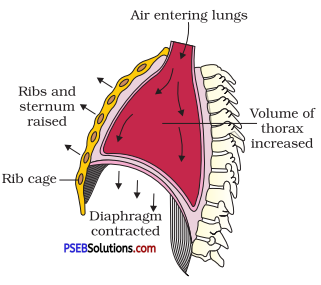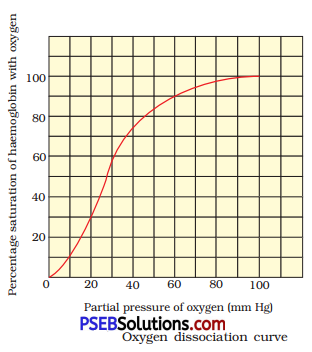Punjab State Board PSEB 11th Class Biology Book Solutions Chapter 17 Breathing and Exchange of Gases Textbook Exercise Questions and Answers.
PSEB Solutions for Class 11 Biology Chapter 17 Breathing and Exchange of Gases
PSEB 11th Class Biology Guide Breathing and Exchange of Gases Textbook Questions and Answers
Question 1.
Define vital capacity. What is its significance?
Answer:
Vital Capacity (VC): The maximum volume of air a person can breathe in after a forced expiration is called vital capacity. Vital capacity is higher in athletes and singers. Vital capacity shows the strength of our inspiration and expiration.
Question 2.
State the volume of air remaining in the lungs after a normal breathing.
Answer:
The volume of air remaining in the lungs even after a forcible expiration averages 1100 ml to 1200 ml.
Question 3.
Diffusion of gases occurs in the alveolar region only and not in the other parts of respiratory system. Why?
Answer:
Alveoli are the primaty sites of gas exchange in the respiratory system. Exchange of gases occur between blood and these tissues. O2 and CO2 are exchanged in these sites by simple diffusion mainly based on pressure/concentration gradient. The diffusion membrane for gas exchange is made up of three major layers.
These layers are :
- Squamous epithelium of alveoli.
- Endothelium of alveolar capillaries.
- Basement substance in between them. Its total thickness is much less than a millimetre. Therefore, all the factors in our body are favourable for diffusion of O2 from alveoli to tissues and that of CO2 from tissues to alveoli.
Question 4.
What are the major transport mechanisms for CO2? Explain.
Answer:
Transport of Carbon Dioxide: CO2 in gaseous form diffuses out of the cells into capillaries, where it is transported in following ways :
(i) Transport in dissolved form: About 7% CO2 is carried in dissolved form through the plasma because of its high solubility.
(ii) Transport as bicarbonate: The largest fraction (about 70%) is carried in plasma as bicarbonate ions (HCO3). At the tissues site, where pCO2 is high due to catabolism, CO2 diffuses into the blood (RBCs and plasma) and forms HCO3– and H–.

This reaction is faster in RBCs because they contain an enzyme carbonic anhydrase. Hydrogen ion released during the reaction bind to Hb, triggering the Bohr effect.
At the alveolar site, where pCO2 is low, the reaction proceeds in opposite direction forming CO2 and H2O. Thus, CO2 trapped as bicarbonate at tissue level and transported to alveoli is released as CO2.
(iii) Transport as carbaminohaemoglobin: Nearly 20-25% CO2 is carried by haemoglobin as carbaminohaemoglobin, CO2 entering the blood combines with the NH2 group of the reduced Hb.
![]()
The reaction releases oxygen from oxyhaemoglobin.
Factors affecting the binding of CO2 and Hb are as follows:
- Partial pressure of CO2.
- Partial pressure of O2 (major factor).
In tissues, pCO2 is high and pO2 is low, more binding of CO2 occurs while, in the alveoli, pCO2 is low and pO2 is high, dissociation of CO2 from HbCO2 takes place, i.e., CO2, which is bound to Hb from the tissues is delivered at the alveoli.
![]()
Question 5.
What will be the pO2 and pCO2, in the atmospheric air compared to those in the alveolar air?
(i) pO2 lesser and pCO2 higher
(ii) pO2 higher and pCO2 lesser
(iii) pO2 higher and pCO2 higher
(iv) pO2 lesser and pCO2 lesser
Answer:
(i) In the alveolar tissues, where low pO2, high pCO2, high H+ concentration, these conditions are favourable for dissociation of oxygen from the oxyhaemoglobin.
(ii) When there is high pO2, low pCO2, less H+ concentration and lesser temperature, the factors are all favourable for formation of oxyhaemoglobin.
(iii) When pO2 is high in the alveoli and pCO2 is high in the tissues then the oxygen diffuses into the blood and combines with oxygen forming oxyhaemoglobin and CO2 diffuses out.
(iv) When pO2 is low in the alveoli and pCO2 is low in the tissues then these conditions are favourable for dissociation of oxygen from the oxyhaemoglobin.
Question 6.
Explain the process of inspiration under normal conditions.
Answer:
Inspiration is the process during which atmospheric air is drawn in. Inspiration is initiated by the contraction of diaphragm, which increases the volume of thoracic chamber in the anteroposterior axis. The contraction of external intercostal muscles lifts up the ribs and the sternum causing an increase in the volume of the thoracic chamber in the dorso-ventral axis.
The overall increase in the thoracic volume causes a similar increase in pulmonary volume. An increase in pulmonary volume decreases the intrapulmonary pressure to less than the atmospheric pressure, which forces the air from outside to move into the lungs, i. e., inspiration. On an average, a healthy human breathes 12-16 times/minute.

Question 7.
How is respiration regulated?
Answer:
Respiratory rhythm centre is primarily responsible for regulation of respiration. This centre is present in the medulla.
Pneumotaxic centre, present in the pons region, also coordinates respiration. Apart from them, receptors associated with aortic arch and carotid artery, can also recognize changes in CO2 and H+ concentration and send signal to the rhythm centre for proper action.
Question 8.
What is the effect of pCO2 on oxygen transport?
Answer:
Partial pressure of CO2 (pCO2) can interfere the binding of oxygen with haemoglobin, i.e., to form oxyhaemoglobin.
(i) In the alveoli, where there is high pO2 and low pCO2, less H+ concentration and low temperature, more formation of oxyhaemoglobin occur.
(ii) In the tissues, where low pO2, high pCO2, high H+ concentration and high temperature exist, the conditions are responsible for dissociation of oxygen from the oxyhaemoglobin.
Question 9.
What happens to the respiratory process in a man going up a hill?
Answer:
At hills, the pressure of air falls and the person cannot get enough oxygen in the lungs for diffusion in blood. Due to deficiency of oxygen, the person feels breathlessness, headache, dizziness, nausea, mental fatigue and a bluish colour on the skin, nails and lips.
![]()
Question 10.
What is the site of gaseous exchange in an insect?
Answer:
The actual site of gaseous exchange in an insect is tracheoles and tracheolar end cells.
Question 11.
Define oxygen dissociation curve. Can you suggest any reason for its sigmoidal pattern?
Answer:
A sigmoid curve is obtained when percentage saturation of haemoglobin with O2 is plotted against the pO2.
This curve is called the oxygen dissociation curve and is highly useful in studying the effect of factors like pCO2, H+ concentration, etc., on binding of O2 with haemoglobin.

In the alveoli, where there is high pO2, low pCO2, lesser H+ concentration and lower temperature, the factors are all favourable for the formation of oxyhaemoglobin, whereas in the tissues, where low pO2, high pCO2, high H+ concentration and higher temperature exist, the conditions are favourable for dissociation of oxygen from the oxyhaemoglobin. This dearly indicates that O2 gets bound to haemoglobin in the lung surface and gets dissociated at the tissues. Every 100 ml of oxygenated blood can deliver around 5 ml of O2 to the tissues under normal physiological conditions.
Question 12.
Have you heard about hypoxia? Try to gather information about it, and discuss with your friends.
Answer:
Hypoxia is the shortage of oxygen supply to the blood due to :
(a) normal shortage in air
(b) oxygen deficiency on high mountains (mountain sickness), anaemia and phytotoxicity or poisoning of electron transport system.
Question 13.
Distinguish between:
(a) IRV and ERV
(b) Inspiratory Capacity and Expiratory Capacity
(c) Vital Capacity and Total Lung Capacity
Answer:
(a) IRV and ERV Inspiratory Reserve Volume (IRV): Additional volume of air, a person can inspire by a forcible inspiration. This is about 2500-3000 mL. Expiratory Reserve Volume (ERV): Additional volume of air, a person can expire by a forcible expiration. This is about 1000-1100 mL.
(b) Inspiratory Capacity and Expiratory Capacity Inspiratory Capacity (IC): Total volume of air a person can inspire after a normal expiration. This includes tidal volume and inspiratory reserve volume (TV+IRV).
Expiratory Capacity (EC): Total volume of air a person can expire after a normal inspiration. This includes tidal volume and expiratory reserve volume (TV+ERV)
(c) Vital Capacity and Total Lung Capacity
Vital Capacity (VC): The maximum volume of air, a person can breathe in after a forced expiration. This includes ERV, TV and IRV or the maximum volume of air a person can breathe out after a forced inspiration.
Total Lung Capacity (TLC): Total volume of air accommodated in the lungs at the end of a forced inspiration. This includes RV, ERV, TV and IRV or vital capacity + residual volume.
![]()
Question 14.
What is tidal volume? Find out the tidal volume (approximate value) for a healthy human in an hour.
Answer:
Tidal Volume (TV): Volume of air inspired or expired during a normal respiration is called tidal volume. It is about 500 mL., i.e., a healthy man can inspire or expire approximately 6000 to 8000 mL of air per minute.
